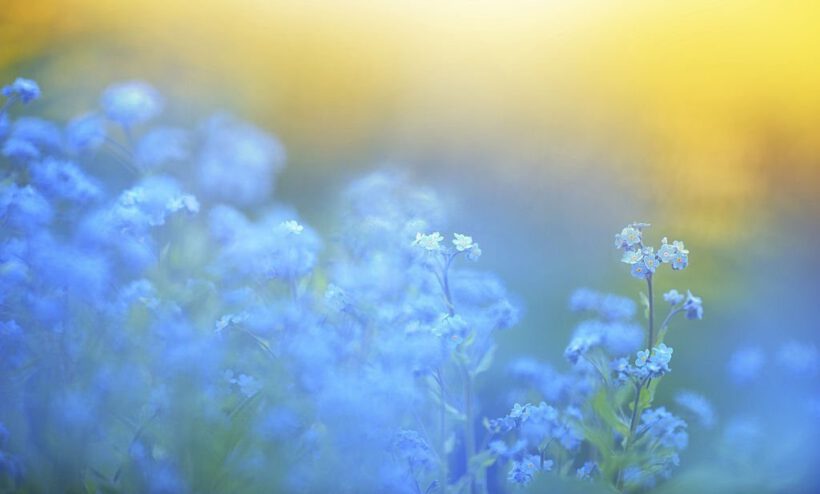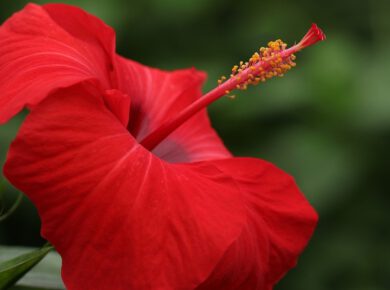Table of Contents Show
Welcome to a journey through the captivating world of blue flowers. Nature has blessed us with an array of mesmerizing blooms that come in various shades of blue. In this article, we will delve into the beauty, symbolism, and cultivation of blue flowers. Whether you’re a passionate gardener or simply appreciate the wonders of nature, this guide will satisfy your curiosity and ignite your love for these enchanting blossoms.
The Fascinating World of Blue Flowers
It possesses a unique charm that sets them apart from other floral hues. Their delicate petals and soothing tones evoke a sense of tranquility and serenity. Imagine walking through a garden adorned with azure blossoms, their vibrant colors standing amidst a sea of green. Blue flowers have a mystical allure that captivates the senses and enchants the beholder.
Blue Bell Flowers: Nature’s Symphony
Blue bell flowers, also known as Campanula, are nature’s symphony in blue. These bell-shaped blooms are characterized by their elegant, downward-facing petals that resemble tiny bells. Delicate and ethereal, blue bell flowers add grace and elegance to any garden or floral arrangement. From the enchanting Bluebells of Scotland to the charming Canterbury Bells, these flowers paint the landscape with their vivid blue hues.
Blue Bonnet Flowers: Beauty in the Wild
Blue bonnet flowers are a symbol of untamed beauty, often found growing in the wild. These vibrant blossoms grace open fields and meadows, offering a delightful spectacle of blue. The iconic Texas Bluebonnet, with its cone-shaped clusters of blue petals, is a cherished symbol of the Lone Star State. These hardy flowers are not only visually stunning but also play a vital role in supporting pollinators and preserving natural habitats.
Light Blue Flowers: Illuminating Your Garden
Light blue flowers bring a touch of ethereal beauty to any garden. These gentle blooms, such as the forget-me-not and baby’s breath, exude a sense of innocence and purity. Their subtle shades of blue create a serene and peaceful ambiance, making them ideal for creating tranquil garden spaces or as accents in floral arrangements.
Blue Perennial Flowers: Timeless Elegance
Blue perennial flowers are a gardener’s dream, offering lasting beauty year after year. These enduring favorites are known for their resilience and ability to thrive in various climates. Here are a few beloved blue perennial flowers:
Dyson Hair Dryer Reviews: The Ultimate Guide to the Perfect Hair Dryer
- Lupine: With its vibrant spikes of blue flowers, the lupine adds height and drama to garden beds. These hardy perennials are a favorite among pollinators and garden enthusiasts alike.
- Balloon Flower: The balloon flower derives its name from the unique shape of its buds, which resemble miniature hot air balloons. When they open, they reveal stunning blue petals that enchant onlookers.
- Veronica: Also known as speedwell, veronica boasts graceful spikes of blue flowers that attract bees and butterflies. These versatile perennials are perfect for borders and rock gardens.
Captivating Names of Blue Flowers
It has names as captivating as their appearance. Let’s explore some of the most enchanting blue flowers and the stories behind their names:
- Gentian: Named after the legendary Greek king Gentius, these intense blue blooms embody royalty and elegance.
- Forget-Me-Not: According to folklore, a medieval knight picked these tiny blue flowers for his beloved and fell into a river. As he threw the flowers to her, he shouted, “Forget-me-not!” thus giving them their sentimental name.
- Cornflower: With its vibrant blue petals, the cornflower has long been associated with rural landscapes and was commonly found in cornfields, hence its name.
- Iris: Derived from the Greek word for “rainbow,” the iris flower comes in a range of hues, including stunning shades of blue. It symbolizes hope, wisdom, and courage.
- Morning Glory: These enchanting flowers unfurl their vibrant blue petals in the morning, bringing a sense of joy and new beginnings.
- Bachelor’s Button: Bachelor’s button, scientifically known as Centaurea cyanus, is a charming annual flower with vivid blue petals. Easy cultivation and long-lasting blooms make it a popular choice for beginners and experienced gardeners.
- Hydrangea: Hydrangeas are versatile shrubs that produce beautiful clusters of flowers. While they are known for their ability to change color based on soil acidity, certain varieties showcase mesmerizing shades of blue.
- Delphinium: Delphiniums, part of the Ranunculaceae family, are tall and majestic flowers available in various shades of blue. These perennial blooms are known for their striking vertical growth and are often used to create dramatic floral arrangements.
The Allure of Light Blue Flowers
Light blue flowers have a delicate charm that exudes serenity and calmness. Their soft pastel tones create a soothing atmosphere and evoke feelings of tranquility. Some popular light blue flowers include:
- Hydrangea: Known for its large, fluffy flower heads, the hydrangea offers a stunning display of light blue blooms, making it a favorite in gardens and floral arrangements.
- Delphinium: Tall and majestic, delphiniums showcase elegant spires adorned with clusters of light blue flowers. They add a touch of sophistication to any landscape.
- Bachelor’s Button: Also known as the cornflower, the bachelor’s button boasts charming light blue blossoms that symbolize hope and everlasting love.
Incorporating Blue Flowers in Your Garden
Adding it to your garden can create a captivating and soothing ambiance. Here are some tips for incorporating these stunning blooms into your outdoor space:
- Create a focal point: Plant a cluster of blue flowers in a prominent area of your garden to draw attention and create a visual centerpiece.
- Combine with complementary colors: Pair blue flowers with complementary hues like white, pink, or purple to create a harmonious and eye-catching display.
- Consider the height: Choose blue flowers of varying heights to add depth and dimension to your garden beds. Taller flowers can act as backdrops for shorter ones, creating an enchanting layered effect.
- Explore different bloom times: Select blue flowers that bloom at different times throughout the year to ensure a continuous display of color and beauty.
Growing Blue Flowers: Tips and Tricks
Growing blue flowers requires some knowledge and care to ensure their optimal growth and vibrancy. Here are a few essential tips to help you cultivate these captivating blooms:
- Choose the Right Location: It thrives in well-drained soil and prefers areas with ample sunlight. Ensure your chosen location meets these requirements to provide the best growing conditions.
- Prepare the Soil: Prior to planting, prepare the soil by adding organic matter, such as compost or well-rotted manure. This enriches the soil and provides essential nutrients for healthy plant growth.
- Proper Watering: It generally requires moderate watering. Ensure the soil is evenly moist but not waterlogged. Overwatering can lead to root rot, so it’s essential to strike the right balance.
- Fertilization: Use a balanced fertilizer formulated for flowering plants to promote healthy growth and abundant blooms. Follow the instructions on the fertilizer packaging for best results.
Companion Plants for Blue Flowers
When planning your garden, consider incorporating companion plants that complement the beauty of blue flowers. Here are a few excellent choices:
- Yellow Flowers: Pairing blue flowers with yellow blooms, such as marigolds or coreopsis, creates a striking contrast that adds visual interest to your garden.
- Silver Foliage: Plants with silver or gray foliage, like lamb’s ear or artemisia, serve as excellent companions to blue flowers. The contrasting textures and colors enhance the overall aesthetic appeal.
- White Flowers: White flowers, such as daisies or white roses, create a harmonious combination when planted alongside blue blooms. This classic pairing exudes elegance and purity.
Symbolism and Mythology
Throughout history, it has held special meaning and symbolism in various cultures. They are often associated with tranquility, serenity, and spiritual enlightenment. For example, in Victorian times, it represented loyalty and fidelity. Understanding the symbolism behind blue flowers adds depth and significance to their presence in your garden.
Art and Literature
It has long inspired artists and writers with its captivating beauty. These blossoms have left an indelible mark in art and literature from Van Gogh’s famous “Irises” to Shakespeare’s poetic references. Their allure and symbolism are celebrated in creative works, showcasing their timeless appeal.
Common Challenges in Growing
While they can be a stunning addition to any garden, they present some challenges. Here are a few common issues and how to address them:
- Soil pH: It thrives in slightly acidic soil. If your soil is naturally alkaline, you can lower the pH by adding elemental sulfur or organic amendments like peat moss.
- Pest Control: Keep an eye out for common garden pests, such as aphids or snails, which can damage blue flowers. Use organic pest control methods or consult with a local gardening expert for effective solutions.
- Disease Prevention: Some blue flowers are prone to diseases like powdery mildew or crown rot. Ensure good air circulation, avoid overwatering, and remove any infected foliage promptly to prevent the spread of diseases.
Blue Flowers for Various Garden Styles
It can be incorporated into different garden styles, from formal to cottage gardens. Here are a few ideas:
- English Garden: Create a quintessential English garden with blue delphiniums, lavender, and other traditional cottage flowers.
- Modern Garden: Add a contemporary touch to your garden with blue agapanthus or globe thistles, which thrive in minimalist landscapes.
- Wildflower Garden: Embrace a natural and wild aesthetic by including blue cornflowers, lupines, or meadow sage in your garden.
Blue Flowers for Butterflies and Bees
It is not only visually appealing but also attracts essential pollinators like butterflies and bees. By including blue blooms in your garden, you contribute to preserving these essential insects. Some butterfly and bee-friendly blue flowers include aster, salvia, and borage.
Frequently Asked Questions (FAQs)
What are the best flowers for a summer garden?
Some of the best blue flowers for a summer garden are:
Delphinium
Hydrangea
Cornflower
Balloon Flower
How do I maintain the vibrant blue color of my blue flowers?
To maintain the vibrant blue color of your blue flowers, ensure they receive adequate sunlight, water them properly, and use fertilizers that promote flower color retention. Additionally, avoid planting them in alkaline soil, as it can cause the flowers to turn pink.
Can blue flowers attract specific pollinators?
Yes, it can attract specific pollinators such as butterflies, bees, and hummingbirds. These pollinators are often drawn to the bright blue hues and nectar-rich blooms of blue flowers.
Are there suitable for indoor cultivation?
Yes, several blue flowers can thrive indoors, including:
African Violet
Grape Hyacinth
Balloon Flower (dwarf varieties)
Lobelia (compact varieties)
What are some popular blue flowers for wedding bouquets?
Popular blue flowers for wedding bouquets include:
Blue Hydrangea
Forget-Me-Not
Iris
Cornflower
Can blue flowers change color?
While they generally maintain their color, soil pH and environmental conditions can influence their shade. For instance, some blue hydrangea varieties can turn pink in alkaline soil.
Are blue flowers suitable for shaded areas?
Yes, some flowers, such as columbine or lobelia, can thrive in partially shaded areas. Be sure to check the specific light requirements of each plant before selecting them for shaded spots.
How can I dry blue flowers for crafts and decorations?
To dry them, gather them in small bunches and hang them upside down in a cool, dark, and well-ventilated space. Once dried, they can be used for wreaths, floral arrangements, or other decorative crafts.
Can I grow blue flowers in containers or pots?
Blue lobelia or petunias can be successfully grown in containers or pots. Ensure proper drainage and provide adequate sunlight for optimal growth.


